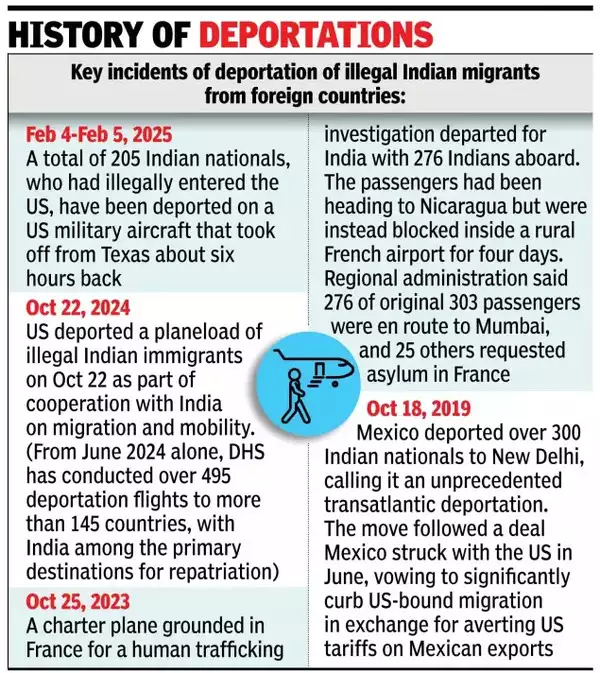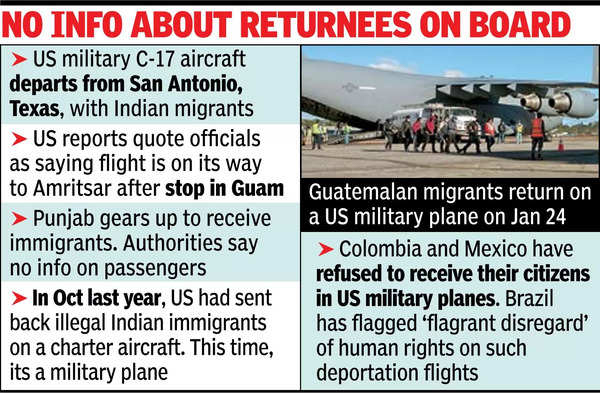- Home
- Prelims
- Mains
- Current Affairs
- Study Materials
- Test Series
 Latest News
Latest News
Deportation of Illegal Immigrants from USA
Deportation refers to the removal of a non-citizen from a country due to violations of immigration laws. It is usually applied to individuals who have overstayed their visas, failed to comply with legal requirements, or are deemed a threat to public safety or national security. The process is conducted by immigration authorities under specific legal frameworks. In the US, the Department of Homeland Security (DHS) oversees deportations. Depending on the case, individuals may face:
- • Expedited removal: Non-citizens may be deported quickly without a court hearing if they are deemed inadmissible under immigration laws.
- • Formal removal orders: This involves a legal process where individuals can defend their case before an immigration judge.
- • Detention: Many non-citizens are detained either at the border, while entering the US, or within the country if they violate their visa conditions.
| Forced displacement or forced migration of an individual or a group may be caused by deportation, for example ethnic cleansing, and other reasons. |
Reasons
- Illegal Immigration Enforcement: The deportations are part of intensified Immigration and Customs Enforcement (ICE) operations aimed at identifying, detaining, and deporting individuals who are in the U.S. without proper documentation.
- Large-Scale Illegal Migration – Many Indians, particularly from Gujarat, Punjab, and Haryana, attempt to enter the U.S. illegally through Mexico and Canada due to economic distress and job shortages.
Impact of US immigration policies on Indian students and professionals
- Legal Migration Channels: The Indian government is keen on ensuring that legal migration channels to the U.S. for Indian nationals are not restricted by the U.S. administration. These legal routes include H-1B visas for skilled workers and visas for students.
- Deterrence of Illegal Migration: Both the U.S. and India are engaged in deterring illegal migration while creating more avenues for legal migration from India to the U.S.
- Increased Deportations: Deportation of Indian nationals from the United States surged by 400% in the past three years. In 2024, 1,529 Indians were deported, a significant jump from 292 in 2021.
- Impact on Undocumented Indians: Approximately 725,000 undocumented Indians reside in the U.S., primarily from Punjab and Gujarat. As of November of the previous year, 20,407 undocumented Indians were either facing final removal orders or were held in detention centers of U.S. Immigration and Customs Enforcement.

Impact on USA
- Labour Market Disruptions: Deportations can create labor shortages in sectors reliant on immigrant workers, such as construction and hospitality. (Example: Indian workers contribute significantly to the U.S. IT and service industries.)
- Diplomatic Tensions: Large-scale deportations may strain U.S.-India relations, especially if handled insensitively. (Example: The use of military flights for deportations sparked protests from other countries like Colombia.)
Political landscape in India
- Domestic Political Fallout: The deportation of thousands of Indians could become a political issue, with opposition parties blaming the government for failing to create adequate job opportunities at home.
- Diplomatic Challenges: The mass deportations could strain India-U.S. relations, particularly if deportees face harsh treatment, triggering diplomatic interventions.
- Public Backlash: The use of military flights and reports of inhumane treatment, such as shackling, may create anti-U.S. sentiment among the Indian public.
- State-Level Political Implications: States with high numbers of deportees (Gujarat, Punjab, Haryana) may experience political unrest, with local governments facing pressure to provide jobs and reintegration support.
- Rise in Anti-Illegal Migration Policies: The Indian government may be compelled to introduce stricter measures against illegal immigration and human trafficking networks, affecting those attempting to migrate illegally.
- Impact on Indian Diaspora Relations: The large-scale return of undocumented migrants could impact remittances, economic support for families, and the broader perception of Indian migrants globally.

India’s Diplomatic Response and Concerns
- India has engaged in diplomatic efforts to manage the immigration issue without affecting bilateral ties:
- India’s Position on Deportation:
- India has agreed to accept undocumented Indians if nationality verification is confirmed.
- External Affairs Minister S. Jaishankar conveyed India’s stand to US Secretary of State Marco Rubio.
- India is against illegal immigration due to its links to organized crime and human trafficking.
- Ensuring Legal Pathways for Migration:
- Over 1 million visas were issued to Indian nationals in 2024, including record numbers of student and business visas.
- 72% of H-1B visas issued in the last fiscal year went to Indian professionals.
- Trump has assured that the H-1B visa program will continue, though some reforms may be introduced.
- Challenges in India-US Talks:
- India has asked for discreet deportation measures to avoid political backlash.
- Concerns remain over potential restrictions on Indian migration programs.
Trump’s Economic Leverage on Immigration Policy
- President Trump has leveraged trade policies to enforce immigration compliance:
- Tariff Impositions on Non-Cooperative Countries:
- Colombia refused to accept a deportation flight—Trump retaliated with 25% tariffs on Colombian goods.
- Canada and Mexico also faced tariff threats, forcing them to ramp up border enforcement.
- The US Congress is considering sanctions on countries not cooperating with deportation orders.
- Impact on India:
- While India has cooperated with the US, it remains cautious of future trade restrictions.
- India’s focus is on protecting its skilled workforce migration and avoiding economic retaliation.
Impact on the Indian Community in the US
- Fear and Uncertainty Among Undocumented Migrants:
- Many Indian undocumented workers are avoiding public spaces due to increased arrests.
- Detentions at workplaces and homes have caused economic strain in low-wage job sectors.
- Legal Migrants Also Affected:
- The H-1B visa program remains uncertain, with possible changes to sponsorship requirements.
- Many Indian students fear tougher visa renewal policies.
- India’s Response:
- India is monitoring the situation closely, ensuring that legal migrants’ rights are protected.
- Diplomatic engagements with US policymakers are focused on preserving employment-based immigration programs.
Road ahead
- Strengthen Domestic Employment Opportunities: Implement targeted economic reforms, boost job creation in high-migration states (Gujarat, Punjab, Haryana), and address the root causes driving illegal migration, such as agricultural distress and unemployment.
- Enhance Public Awareness & Legal Migration Channels: Conduct awareness campaigns on the risks of illegal immigration while expanding safe and legal pathways for skilled migration through bilateral agreements with the U.S. and other countries.
- Engage in Diplomatic & Policy Advocacy: Strengthen diplomatic efforts to ensure fair treatment of deported individuals, negotiate favourable visa policies for Indian professionals and students, and collaborate with the U.S. on workforce mobility solutions.
|
Deportation Rules in India Entry, Stay, Exit of Foreigners in India:
Foreigners Act, 1946:
The Foreigners (Tribunals) Order:
Illegal Migrants (Determination by Tribunals) Act, 1983:
Requirements during arrival of Foreigners in India:
Requirements during Stay In India:
|










 General Studies
General Studies